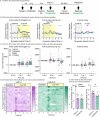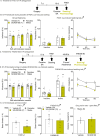This is a preprint.
Dopamine transmission at D1 and D2 receptors in the nucleus accumbens contributes to the expression of incubation of cocaine craving
- PMID: 38979157
- PMCID: PMC11230461
- DOI: 10.1101/2024.06.26.600812
Dopamine transmission at D1 and D2 receptors in the nucleus accumbens contributes to the expression of incubation of cocaine craving
Update in
-
Dopamine transmission at D1 and D2 receptors in the nucleus accumbens contributes to the expression of incubation of cocaine craving.Neuropsychopharmacology. 2024 Dec;50(2):461-471. doi: 10.1038/s41386-024-01992-2. Epub 2024 Sep 19. Neuropsychopharmacology. 2024. PMID: 39300272
Abstract
Relapse represents a consistent clinical problem for individuals with substance use disorder. In the incubation of craving model of persistent craving and relapse, cue-induced drug seeking progressively intensifies or 'incubates' during the first weeks of abstinence from drug self-administration and then remains high for months. Previously, we and others have demonstrated that expression of incubated cocaine craving requires strengthening of excitatory synaptic transmission in the nucleus accumbens core (NAcc). However, despite the importance of dopaminergic signaling in the NAcc for motivated behavior, little is known about the role that dopamine (DA) plays in the incubation of cocaine craving. Here we used fiber photometry to measure DA transients in the NAcc of male and female rats during cue-induced seeking tests conducted in early abstinence from cocaine self-administration, prior to incubation, and late abstinence, after incubation of craving has plateaued. We observed DA transients time-locked to cue-induced responding but their magnitude did not differ significantly when measured during early versus late abstinence seeking tests. Next, we tested for a functional role of these DA transients by injecting DA receptor antagonists into the NAcc just before the cue-induced seeking test. Blockade of either D1 or D2 DA receptors reduced cue-induced cocaine seeking after but not before incubation. We found no main effect of sex in our experiments. These results suggest that DA contributes to incubated cocaine seeking but the emergence of this role reflects changes in postsynaptic responsiveness to DA rather than presynaptic alterations.
Conflict of interest statement
COMPETING INTERESTS Dr. Wolf and OHSU have a financial interest in Eleutheria Pharmaceuticals LLC, a company that may have a commercial interest in results related to the research described herein. This potential conflict of interest has been reviewed and managed by OHSU. Dr. Wolf also serves as a Consultant for the University of Texas-Austin and has received compensation. The other authors declare no competing interests.
Figures





References
-
- Lu L, Grimm JW, Hope BT, Shaham Y. Incubation of cocaine craving after withdrawal: a review of preclinical data. Neuropharmacology. 2004;47:214–26. - PubMed
Publication types
Grants and funding
LinkOut - more resources
Full Text Sources
